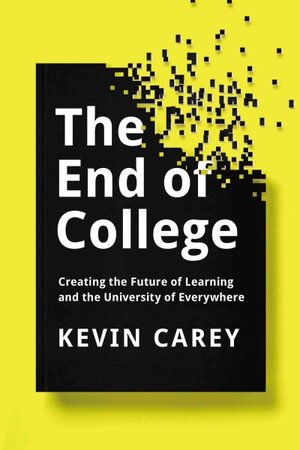“Enrollment in the University of Everywhere will be lifelong, a fundamental aspect of modern living” — “The End of College”
The End of College: Creating the future of Learning and the University of Everywhere is not a doomsday book despite the key words in the title “The END”. A more apt title might be “The End of Traditional College”. Its message is how traditional college, with its institution and research-centric paradigm has less to do with student learning and more to do with an admissions process that is out-of-control, institutions that are far-removed from making student learning a priority, and an out-of-date accreditation system focused on the credit-hour. This will change in the next generation. Carey describes how higher education is, and will continue its transformation to the University of Everywhere, driven by student demand and technology innovations.
There is a sliver of doom in Carey’s writing; he warns that institutions that view education technology as a fad, another trend to be waited out, will come to an end. Colleges that remain unchanged today will disappear tomorrow (pg. 244). Carey’s book echoes the message in Abelard to Apple: The Fate of American Colleges by Richard DeMillo published in the pre-MOOC era (2011). Abelard to Apple is more dire, with an explicit warning for colleges and universities of the ‘middle’ (second tier institutions). According to Demillo the majority of higher education institutions are headed for irrelevance and marginalization unless they take action. Demillo like Carey, wrote that technology is the driver of change, the vehicle for education transformation. Demillo went further, describing how the complexity of the higher education system serves as the most significant barrier to innovation and change. Those that don’t (or won’t) change are destined for demise with one exception—the universities in the ‘ivy league’. Demillo and Carey are in agreement on this point, that the elite schools will be immune, insulated by power and money.
Carey’s book received sharp criticism. Some critics called Carey’s University of Everywhere a utopia of higher education with its education promises of personalized learning, rigorous coursework where students won’t be able to ‘coast’, where technology makes education better, not easier (pg. 248). Carey’s University of Everywhere also dismantles the idea of public institutions as the fulcrum of higher education (in United States) by suggesting they serve a different purpose: for research—yes, places for life-long learning experiences and collaboration—also yes, but undergraduate education taught primarily by distracted faculty engaging in research—no.
There is not now and there never will be a substitute for the deliberate practice necessary to gain real expertise. The higher-learning organizations of the future will give students the right kids of hard work to do, and they will recognize that work by awarding credible evidence of accomplishment. But they won’t do students’ work for them. What parents can do is to hep their children build the intellectual and emotional tools they will need for the demanding and rewarding tasks. (pg 248)
Matt Reed, one of the book’s critics, suggests in a blog post at Inside Higher Ed that the mission of public university will be comprised with Carey’s suggested model, to the detriment of society. Audrey Watters agrees, stating in “Techno Fantasies” that Carey’s model is deeply flawed, citing the rise of private entities such as MOOC provider Coursera and Udacity as evidence that online education is flawed and that research supporting the effectiveness of technology-driven learning is “paltry” at best.
But the critics miss Carey’s main point. He is not saying MOOCs will replace higher education or that public universities will be obsolete. Nor is he saying technology is the answer to higher education’s woes. He is saying that there will be a shift in the higher education model in the next generation, that brick and mortar institutions will play a different role and information technology is an important part of achieving education goals, but that the system associated with higher education involving accreditation, delivery, admissions, research, access, and cost associated with education, will change because of technology. Just like in any other industry, like medicine or manufacturing, where technology brings about transformation that leads to improvements in quality and lowered costs.
Carey does discuss MOOCs, in fact he describes his experience taking a MOOC on the edX platform. He also discusses Minerva, a new university based on the elite education-model without walls, and new models of accreditation based on digital learning identities. Carey shares these narratives with readers to emphasize the alternatives to a model of education that has changed little over decades, with few improvements in aspects of quality and accessibility. That’s Carey’s main point—the shift to a University of Everywhere will provide more access to education, improve quality and lower costs because of advancements in technology, and a shift in culture, our values and expectations.
The idea of “admission” to college will become an anachronism, because the University of Everywhere will be open to everyone. It won’t in fact, be single place or institution at all. The next generation of students will not waste their teenage years jostling of spot in a tiny number of elitist schools. Their educational experience will come from dozens of organizations, each specializing in different aspects of human learning. (pg 5)
Conclusion
Educators and parents who are eager to learn about the future and possibilities of higher education will find The End of College: Creating the future of Learning and the University of Everywhere insightful and instructive. The book is even more applicable to those who want to be part of the change for the next generation of learning, the beginning of a new paradigm of learning that literally is everywhere.
- Carey, K. (2015). The end of college: Creating the future of learning and the university of everywhere. New York, NY: Riverhead Books.
- DeMillo, R. A. (2011). Abelard to Apple: The fate of American colleges and universities. Cambridge, MA: MIT Press.
